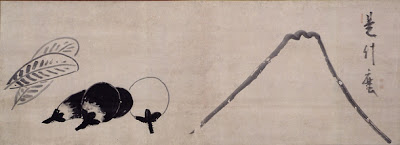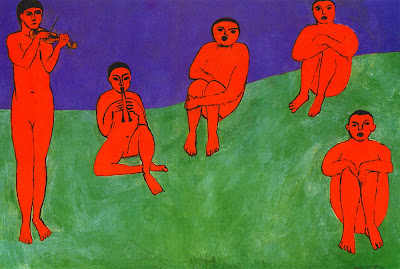 hakuin ekaku, mount fuji and eggplants
hakuin ekaku, mount fuji and eggplantsso what makes the above painting/drawing tick? i'm not sure it even ticks for me. must see it for real. these internet reproductions definitely fall short. am i strange to notice a large similarity with matisse?
somewhere, i think many famous `modern' artists (say past 1900) have been striving to attain some purification/simplification, the results of which have zenlike qualities (imnsho).
 henri matisse, music
henri matisse, musiczen, experiencing of reality and quality before rationalization sets in. art...can also be experiencing of reality and quality before rationalization sets in.
but what does this have to do with bioaesthetics? i think it depends on points of view, definitions also (always the definitional problem which has to be dealt with if you are limited to words). but modulo that, there is much to be said for the idea that certain visual effects/images/colours/symbols/... work on our limbic system, pre-rationally or at least para-rationally.
but is this a static phenomenon? i'm convinced this is not so. developing visual sensitivity, developing visual libraries, developing visual emotionality...is both an ongoing cultural process as an ongoing individual process.
an insect reacting differently to different colours of flowers already shows us that bioaesthetics has a solid basis in biology. by solid i mean, verifiable and easily understandable. to skip to the human level, one only has to look at movie stars...they are invariably quite above average handsome/attractive/beautiful. well, according to what handsome/attractive/beautiful means i suppose. but bioaesthetically, there is quite some knowledge at what human beings consider to be handsome/attractive/beautiful. and again this knowledge is solid in the above sense. symmetrical face, good physical shape, good sexual shape. all is usually explained in terms of the current ideas of `offspring optimization' or `the selfish gene' and similar.
but you and i know that beauty is just skin deep...or is it? what about beauty of the heart, the mind, the soul? many artists appeal to the bioaesthetic kindergartenlevel. nice face, nice tits, nice ass & pussy, even the abundance of the naked female torso in art (headless! limbless! to me associating mostly with brutal crime) which can only -is there another explanation?- appeal to our reproductive sex bioaesthetical level. yet a stiff dick is taboo, and explicit sexual imagery is labeled pornographic and shunned.
one would not believe, i really mean this, how much an artist who addresses higher levels (although, what is higher, but see this in the light of higher mind functions, higher emotions etc) of bioaesthetics has to explain to `lay' people, in comparison to artists who produce yet the next mutilated female body.
so, inner compass? yes, of course. it is not in any sense objectifiably better (by its nature!) than generalized pagerank - outer compass, but the balance in modern society between inner and outer compass to me seems very much in need of restoration.




